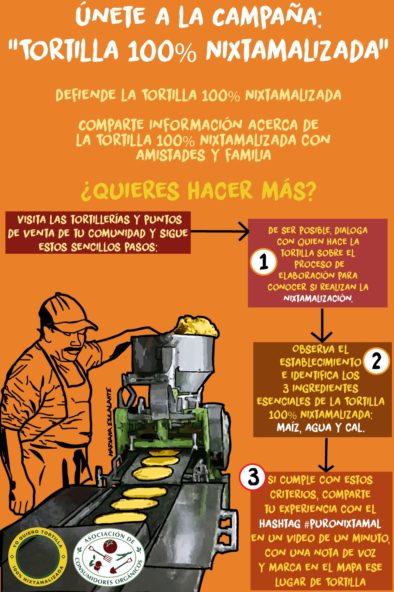It is hard to imagine Mexican culture without corn. To make the most of this traditional, popular domesticated plant, Mexicans have developed a variety of dishes popularly referred to as “Vitamin T:” tacos, tortas, tlayudas, tlacoyos, tamales and the queen of them all, the tortilla.
Tortillas are popular in the U.S., too. So popular that they’re outselling quintessential U.S. fast food staples like burger and hot dog buns. According to the Tortilla Industry Association, tortillas are more popular today in the U.S. than all other ethnic breads, including bagels, English muffins and pita.
When prepared correctly, tortillas provide many nutritional benefits. The key to unlocking these benefits lies in an ancient tradition that is still practiced in Mexico, Central America and even in some places in the U.S and Canada—nixtamalization, a preparation process that uses lime water, flake lime, pickling lime and calcium hydroxide.
Unfortunately, as tortilla-making became industrialized, nixtamalization was replaced by a more efficient, but less beneficial production process.
To defend and protect the traditional nixtamalization process, and to ensure that no GMO corn is allowed in the production of nixtamalized tortillas, Asociación de Consumidores Orgánicos (Organic Consumers Association Mexico) has launched the “Yo quiero mi Tortilla 100% Nixtamalizada” (“I want a 100% Nixtamalized Tortilla).
Nixtamalization: a pre-Hispanic tradition
The word “nixtamalización” is a contraction of two words from Nahuatl, one of the most widely spoken indigenous languages in Mexico. The two words are “Nextli” (ashes) and “tamalli” (cooked corn dough). The process of nixtamalization consists of soaking corn in an alkaline limewater solution for eight hours to make the corn more digestible and to enhance its nutritional value.
On a chemical level, nixtamalization frees the niacin that exists naturally in corn and makes it available for absorption into the body. It also increases the protein levels (via alkalinization) and provides more calcium, iron, folate, copper and zinc to corn.
The nixtamalization process is used for more than 300 different corn-based foods, but the tortilla is the most prominent among them. In Mexico, 264 pounds of tortillas a year are consumed per capita. Adult Mexicans eat between 8-10 tortillas a day, while children eat two per day. Tortillas supply 35 percent of the protein, 45 percent of the calories and 50 percent of daily intake of calcium in the average Mexican diet.
Unfortunately, industrially produced tortillas are nutritionally inferior to tortillas produced using the traditional nixtamalization process. That’s because the industrial process for producing tortillas uses an enzymatic process that produces a lesser-quality cornmeal. It’s also because most industrial tortilla producers use GMO (genetically engineered) corn, typically imported from the United States. Their goal is to produce as many tortillas as possible per hour, regardless of the quality of the final product.
The industrialization of tortillas
Why replace a process that maximizes the nutritional value of Mexico’s most popular food? So industrial producers can make as many tortillas as possible per hour, regardless of the quality of the final product.
During the Green Revolution in the 1940s, native Mexican varieties of corn were slowly replaced by hybrid breeds that contain more starch, resulting in more dough-per-kernel in the final product. This quest for higher starch yields resulted in the loss of other beneficial parts of corn, such as proteins and fats.
During those years the first two dough factories were established—Molinos Azteca S.A (Maseca) and Maíz Industrializado S.A (Minsa), a parastatal corporation (separate from the government but whose activities directly or indirectly serve the state). The two companies conducted government-subsidized research and development, which eventually led to a new, simpler tortilla-making process consisting of merely adding water to artificially enriched corn.
The new process produced more tortillas, faster—but by replacing the nixtamalization process, the nutritional value of the corn, and ultimately the tortillas, was sacrificed.
Defending tortillas: Join our campaign
OCA Mexico’s “Yo quiero mi Tortilla 100% Nixtamalizada” campaign aims to educate consumers about the benefits of nixtamalization and to raise awareness about the artificially enriched corn meal that corporations like Maseca use in their industrialized tortillas, which they often misrepresent as nixtamalized tortillas.
Informed consumers can then use their purchasing power to pressure policymakers to better regulate the use of this sacred word nixtamalization.
With proper regulations in place, subsidies would no longer go to big industrialized tortilla producers like Maseca, but instead to small producers who still respect and practice the ancient process of nixtamalization.
Whether in the U.S. or Latin America, all consumers should be made aware of what crucial nutritional benefits might be lacking in their tortillas.
Get involved
Join our campaign: “Tortilla 100% Nixtamalizada” by visiting http://consumidoresorganicos.org/yo-quiero-mi-tortilla-100-nixtamalizada/
To support traditional tortilla makers, follow these simple steps:
1. Identify the three main ingredients of nixtamalized tortillas: water, corn and lime.
2. If possible, talk to the people making tortillas about the process of production and see if they follow a nixtamalization process.
3. If they do, share your experience with us using the hashtag #puronixtamal with a one-minute video, and add the tortillería to our collaborative map
More information:
http://consumidoresorganicos.org/yo-quiero-mi-tortilla-100-nixtamalizada/
Link to map:
https://www.google.com/maps/d/viewer?mid=1CtpMu5pBlbKX6JwkXUJlqf7Ca3c&usp=sharing

